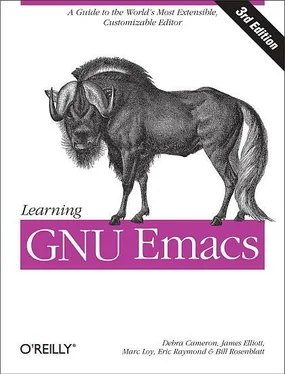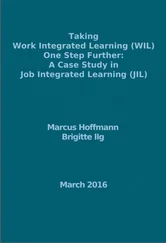Thanks are also due to Marc, both for initially introducing me to the fine folks at O'Reilly and for his help and input on this book. He ended up contributing more than he signed up for when I got pulled away in the middle. Nor should I forget my fine colleagues at GE's Corporate Research and Development Center in Niskayuna, New York who first introduced me to the mysteries of Emacs as an intern there. I'm indebted to Joe for his love and support. And let's hear it for the cast of thousands who have grown Emacs into what it is today!
Marc Loy: I have the occasionally lazy—no, let's say overworked—staff at the University of Southern California's computer labs to thank for getting me started on Emacs. They were out of vicheat sheets when I sat down to write my first computer program. (I won't admit to the language I had to use.) I've been grateful for that happenstance ever since. I'd also like to thank Jim and Deb for their cheery outlook on things as we finished up this latest edition. As always, my sister Amy and my partner Ron remain constant forces for good in my world and make all the silliness (like politics) surrounding the fun stuff (like writing about Emacs) tolerable.
Eric Raymond: My thanks go first to the hacker community at large, all the people who created the rich tradition of Emacs Lisp programming that takes Emacs customization from elegant theoretical possibility to practical tool. I learned what I know partly from reading code written by the likes of Olin Shivers, Jamie Zawinski, Kyle Jones, Barry Warsaw, Roland McGrath, Richard Stallman himself (of course), and many others. Secondly, my thanks and warmest love go as always to my wife Catherine, who supported me on many levels while I worked on my bits of this book. Finally, my thanks and respect to the hip, professional, and clueful people at O'Reilly. They know how to produce a good book and how to treat an author right. They care, and it shows.
Bill Rosenblatt: I would like to thank the following people: Professor Richard Martin (Princeton Classics Department), for planting the seed in me that eventually turned writing from a chore to a pleasure; Intermetrics, Inc., for giving me little enough to do that I could fritter away my workdays delving into GNU Emacs; Hal Stern, for getting me this gig; Sandy Wise, for his help; Jessica Lustig, for her love and support; and most importantly, my grad-school housemates for putting up with a tied-up phone line at all hours of the day and night.
Some of you out there are probably dying to get your hands on the keyboard and start typing. We won't try to stop you; turn to the section called "Starting Emacs" and you can go ahead. But do read the beginning of this chapter later when you're ready for a break. Emacs is much easier to learn if you understand some of the basic concepts involved, which we discuss in the following introduction.
GNU Emacs is one of the most commonly used text editors in the world today. Many users prefer Emacs to vi(Unix's standard editor) or to other GUI text editors. Why is Emacs so popular? It isn't the newest tool, and it's certainly not the prettiest. But it may well be the most useful tool you'll ever learn. We want to present what you need to know about Emacs to do useful work, in a way that lets you use it effectively. This book is a guide for Emacs users; it tries to satisfy the needs of many readers, ranging from casual users to programmers.
Our approach therefore isn't to tell you absolutely everything that Emacs does. It has many features and commands that this book doesn't describe. We don't think that's a problem; Emacs has a comprehensive online help facility that helps you figure out what these are. We focus our attention on describing how to get useful work done. After covering basic editing in the first three chapters, we describe how to use Emacs as a comprehensive working environment: how to boost productivity with multiple buffers and windows, how to give commands without leaving the editor, how to take advantage of special editing modes, how to use Emacs for editing special types of files (source files for various programming languages), and so on. We cover the most important commands and the most important editing modes. However, you should always keep one principle in mind: Emacs does many things well, but it isn't important for that reason. Emacs is important because of the integration of different things you need to do.
What does integration mean? A simple example will help. Assume that someone sends you a mail message describing a special command for accessing a new printer. You can fire up an Emacs shell, paste the command into Emacs, and execute it directly. If it works, you can edit your startup file to create an alias for the command. You can do all this without leaving the editor and without having to retype the command once. That's why Emacs is so powerful. It's more than just an editor; it's a complete environment that can change the way you work.
An initial word of advice, too. Many people think that Emacs is an extremely difficult editor to learn. We don't see why. Admittedly, it has a lot of features, and you probably will never use all of them. But any editor, no matter how simple or complex, has the same basic functions. If you can learn one, you can learn any of them. We'll give you the standard mnemonic devices that will help you remember commands (like " C-pmeans previous line"), but we really don't think even these are necessary. They get you over an initial hump in the learning process but don't make much difference in the long run. Learning to use an editor is basically a matter of learning finger habits: learning where to put your fingers to move to the previous line. If you experiment with Emacs and try typing a few of our examples, you'll quickly acquire these finger habits. And after you've acquired these habits, you'll never forget, any more than you'll forget how to ride a bicycle. After using Emacs for a day or two, we never had to think, " C-pmeans previous line." Our fingers just knew where to go. Once you're at this point, you're home. You can become creative with Emacs and start thinking about how to put its features to work for you. Emacs has extensive menus, but we still recommend learning the key bindings for commonly used commands. Good finger habits can make you an incredibly fast typist, and reaching from keyboard to mouse only slows you down.
The finger-habits approach also implies a different way of reading this book. Intellectually, it's possible to absorb a lot from one reading, but you can form only a few new habits each day. (Unless, of course, they're bad habits.) Chapter 2covers most of the basic editing techniques you'll use. You may need to read it several times, with a slightly different focus each time. For example, Emacs gives you many different ways to move forward: you can move forward one character, one word, one line, one sentence, one paragraph, one page, and so on. All of these techniques are covered in Chapter 2. Start by learning how to move forward and backward, then gradually add more complex commands. Similarly, Emacs provides many different techniques for searching through a file, covered in Chapter 3 Chapter 3. Search and Replace The commands we discussed in the first two chapters are enough to get you started, but they're certainly not enough to do any serious editing. If you're using Emacs for anything longer than a few paragraphs, you'll want the support this chapter describes. In this chapter, we cover the various ways that Emacs lets you search for and replace text. Emacs provides the traditional search and replace facilities you would expect in any editor; it also provides several important variants, including incremental searches, regular expression searches, and query-replace. We also cover spell-checking here, because it is a type of replacement (errors are sought and replaced with corrections). Finally, we cover word abbreviation mode; this feature is a type of automatic replacement that can be a real timesaver.
. Don't feel obliged to learn them all at once; pick something, practice it, and move on to the next topic. No one will complain if you have to work through the first three chapters of our book several times before you're comfortable. Time spent developing good habits is time well spent.
Читать дальше












